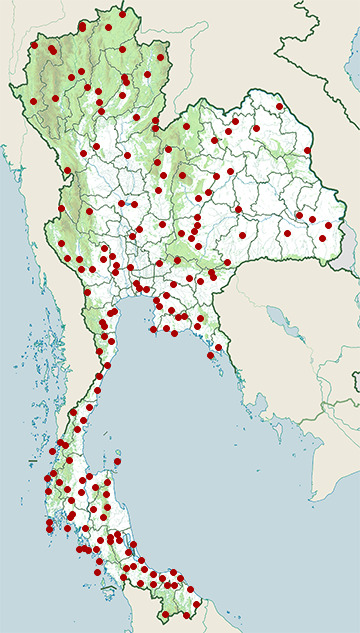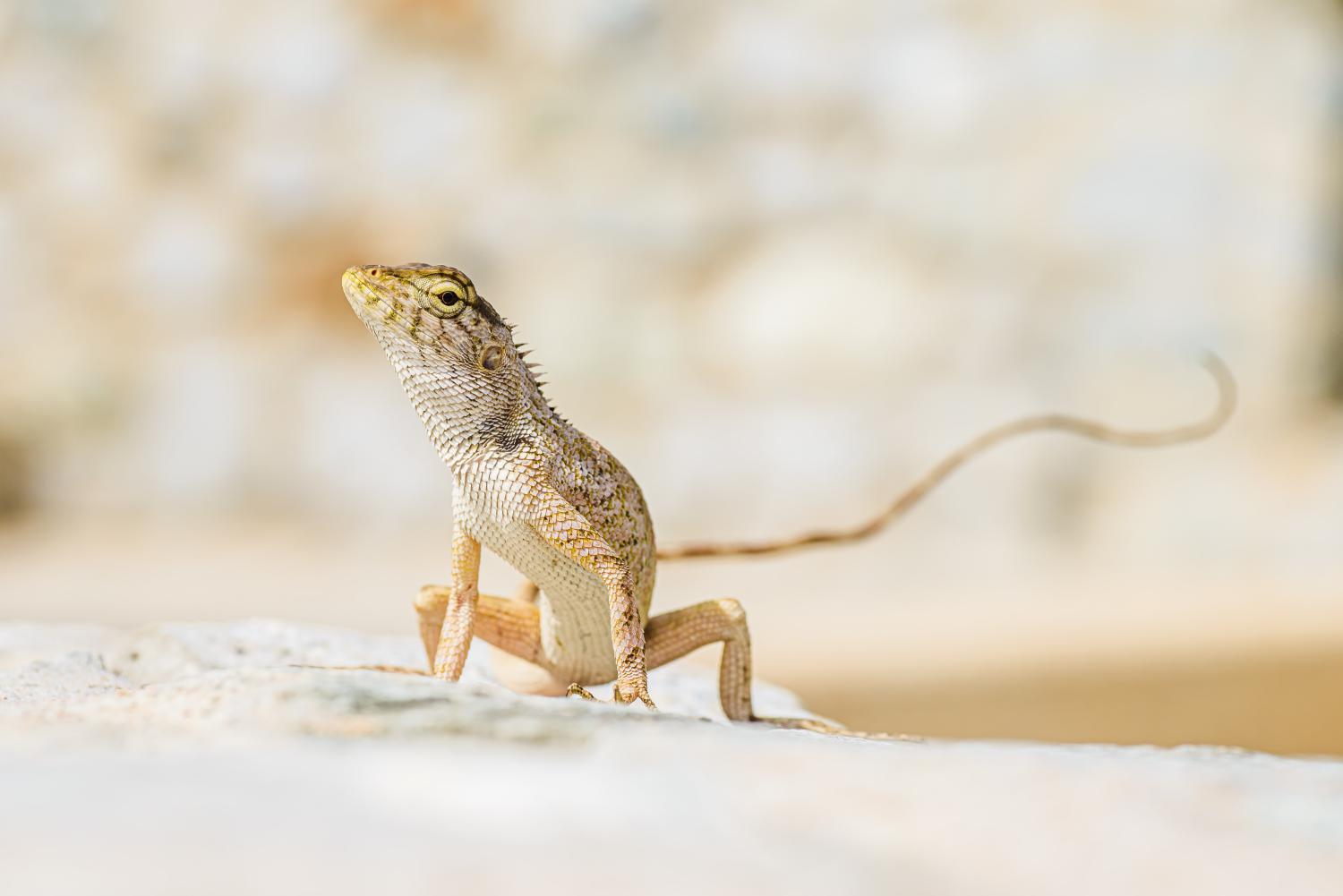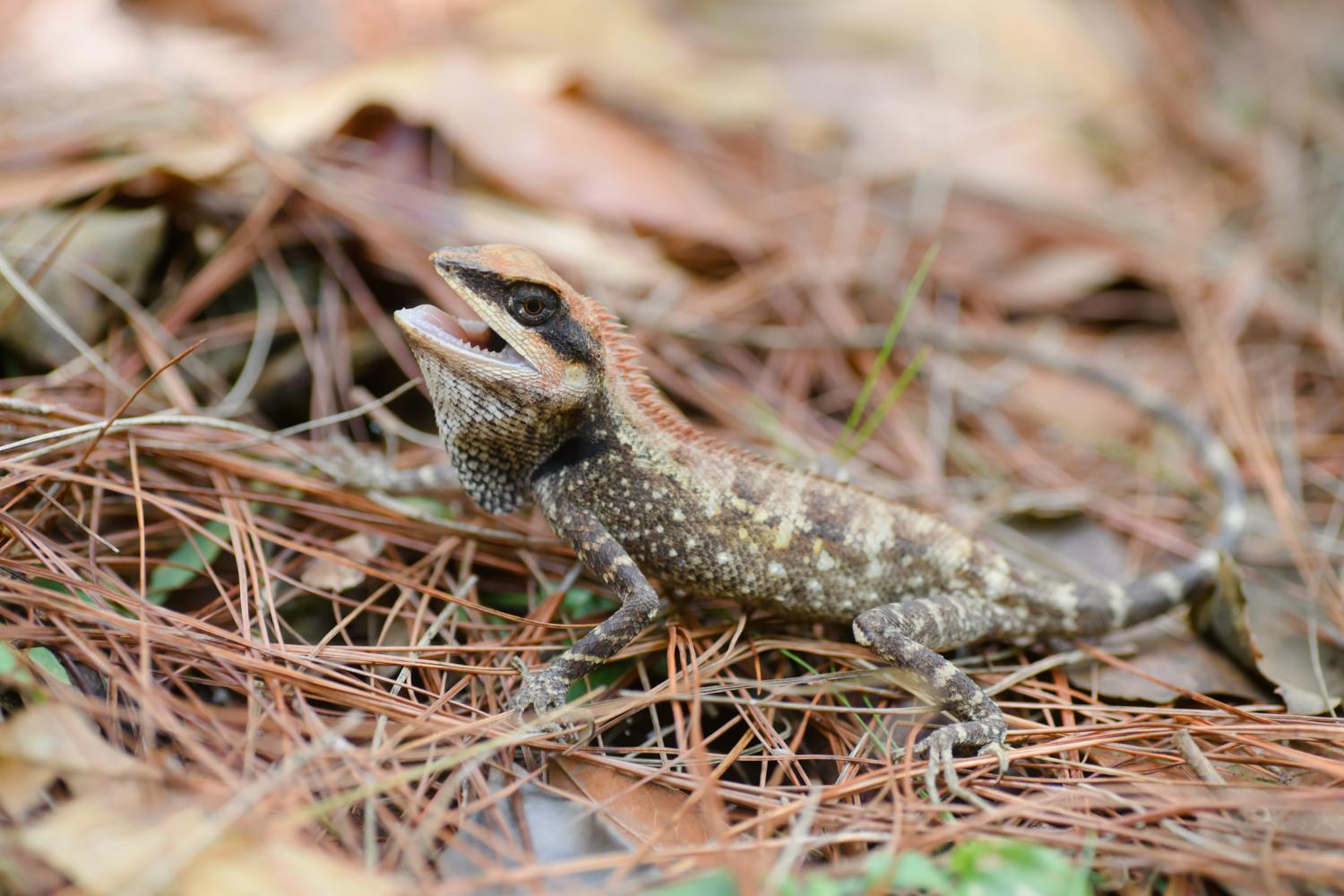Species of Thailand
Ayeyarwady crested lizard
Calotes irawadi
George Robert Zug, Herrick H. K. Brown, James A. Schulte, Jens V. Vindum, 2006
In Thai: กิ้งก่าคอแดง
* No content available for this species yet *
Scientific classification
- Kingdom
- Animalia
- Phylum
- Chordata
- Class
- Reptilia
- Order
- Squamata
- Suborder
- Lacertilia
- Family
- Agamidae
- Genus
- Calotes
- Species
- Calotes irawadi
Common names
- German: Verschiedenfarbige Schönechse
- English:
- Oriental garden lizard
- Eastern garden lizard
- Indian garden lizard
- Common garden lizard
- Bloodsucker
- Changeable lizard
- Thai:
- กิ้งก่าคอแดง
- กิ้งก่าหัวแดง
- กิ้งก่าสวน
Subspecies
Calotes versicolor farooqi, Walter Auffenberg & H. Rehmann, 1995
Calotes versicolor versicolor, François Marie Daudin, 1802
Photos
Please help us review our species pages if wrong photos are used or any other details in the page is wrong. We can be reached via our contact us page.
Range Map

- Ban Dan Lan Hoi District, Sukhothai
- Ban Lat District, Phetchaburi
- Ban Mi District, Lopburi
- Ban Na District, Nakhon Nayok
- Bang Phli District, Samut Prakan
- Bang Saphan District, Prachuap Khiri Khan
- Bangkok Province
- Betong District, Yala
- Bueng Khong Long Non-Hunting Area
- Chai Badan District, Lopburi
- Chana District, Songkhla
- Chiang Saen District, Chiang Rai
- Chun District, Phayao
- Det Udom District, Ubon Ratchathani
- Doi Khun Tan National Park
- Doi Pha Hom Pok National Park
- Doi Phu Kha National Park
- Doi Saket District, Chiang Mai
- Dong Yai Wildlife Sanctuary
- Erawan National Park
- Fang District, Chiang Mai
- Hala-Bala Wildlife Sanctuary
- Hang Dong District, Chiang Mai
- Hat Yai District, Songkhla
- Hua Hin District, Prachuap Khiri Khan
- Huai Kha Khaeng Wildlife Sanctuary
- Huai Krachao District, Kanchanaburi
- Kabin Buri District, Prachinburi
- Kaeng Krachan District, Phetchaburi
- Kaeng Krung National Park
- Kamphaeng Saen District, Nakhon Pathom
- Kantang District, Trang
- Kham Thale So District, Nakhon Ratchasima
- Khao Banthat Wildlife Sanctuary
- Khao Chamao District, Rayong
- Khao Khiao - Khao Chomphu Wildlife Sanctuary
- Khao Khitchakut District, Chanthaburi
- Khao Kho District, Phetchabun
- Khao Kradong Forest Park
- Khao Laem Ya - Mu Ko Samet National Park
- Khao Nam Khang National Park
- Khao Phanom Bencha National Park
- Khao Pu - Khao Ya National Park
- Khao Sok National Park
- Khao Yai National Park
- Khian Sa District, Surat Thani
- Khlong Thom District, Krabi
- Khok Pho District, Pattani
- Khon Sawan District, Chaiyaphum
- Khuan Khanun District, Phatthalung
- Khueang Nai District, Ubon Ratchathani
- Khura Buri District, Phang Nga
- Ko Bulon Le
- Ko Chang District, Trat
- Ko Lanta National Park
- Ko Muk
- Ko Ngai
- Ko Phayam
- Ko Phra Thong
- Ko Samui District, Surat Thani
- Ko Sukon
- Kui Buri National Park
- Lam Nam Nan National Park
- Lan Saka District, Nakhon Si Thammarat
- Lao Khwan District, Kanchanaburi
- Lat Bua Luang District, Phra Nakhon Si Ayutthaya
- Lom Kao District, Phetchabun
- Lum Nam Pai Wildlife Sanctuary
- Mae Sariang District, Mae Hong Son
- Mae Tha, Lampang District, Lampang
- Mae Yom National Park
- Mueang Chaiyaphum District, Chaiyaphum
- Mueang Chiang Rai District, Chiang Rai
- Mueang Chonburi District, Chonburi
- Mueang Chumphon District, Chumphon
- Mueang Kanchanaburi District, Kanchanaburi
- Mueang Khon Kaen District, Khon Kaen
- Mueang Krabi District, Krabi
- Mueang Lampang District, Lampang
- Mueang Loei District, Loei
- Mueang Nakhon Sawan District, Nakhon Sawan
- Mueang Nan District, Nan
- Mueang Narathiwat District, Narathiwat
- Mueang Nongbua Lamphu District, Nong Bua Lamphu
- Mueang Phatthalung District, Phatthalung
- Mueang Phetchabun District, Phetchabun
- Mueang Phetchaburi District, Phetchaburi
- Mueang Phitsanulok District, Phitsanulok
- Mueang Phuket District, Phuket
- Mueang Prachuap Khiri Khan District, Prachuap Khiri Khan
- Mueang Ranong District, Ranong
- Mueang Rayong District, Rayong
- Mueang Sa Kaeo District, Sa Kaeo
- Mueang Sing Buri District, Sing Buri
- Mueang Songkhla District, Songkhla
- Mueang Surat Thani District, Surat Thani
- Mueang Tak District, Tak
- Mueang Trang District, Trang
- Mueang Trat District, Trat
- Mueang Ubon Ratchathani District, Ubon Ratchathani
- Mueang Udon Thani District, Udon Thani
- Mueang Yala District, Yala
- Nam Phong National Park
- Namtok Si Khit National Park
- Ngao Waterfall National Park
- Non Thai District, Nakhon Ratchasima
- Nong Muang Khai District, Phrae
- Nong Phai District, Phetchabun
- Nong Yai District, Chonburi
- Nopphitam District, Nakhon Si Thammarat
- Op Luang National Park
- Pai District, Mae Hong Son
- Pak Phayun District, Phatthalung
- Pak Thong Chai District, Nakhon Ratchasima
- Pang Sida National Park
- Pathio District, Chumphon
- Phanat Nikhom District, Chonburi
- Phanom District, Surat Thani
- Phanom Sarakham District, Chachoengsao
- Phen District, Udon Thani
- Phi Phi Islands
- Phibun Mangsahan District, Ubon Ratchathani
- Phop Phra District, Tak
- Phra Pradaeng District, Samut Prakan
- Phra Thong Kham District, Nakhon Ratchasima
- Phu Khiao Wildlife Sanctuary
- Phu Soi Dao National Park
- Phu Suan Sai National Park
- Phunphin District, Surat Thani
- Phutthaisong District, Buriram
- Plai Phraya District, Krabi
- Pran Buri District, Prachuap Khiri Khan
- Raman District, Yala
- Saba Yoi District, Songkhla
- Sadeth Naikrom - Krom Luang Wildlife Sanctuary
- Sai Buri District, Pattani
- Sai Yok District, Kanchanaburi
- Sai Yok National Park
- Sathing Phra District, Songkhla
- Sattahip District, Chonburi
- Sawang Daen Din District, Sakon Nakhon
- Sawi District, Chumphon
- Sikhio District, Nakhon Ratchasima
- Sirindhorn Peat Swamp Forest
- Song District, Phrae
- Song Phi Nong District, Suphan Buri
- Suan Phueng District, Ratchaburi
- Sung Noen District, Nakhon Ratchasima
- Tai Rom Yen National Park
- Takua Pa District, Phang Nga
- Tha Mai District, Chanthaburi
- Tha Tako District, Nakhon Sawan
- Tha Yang District, Phetchaburi
- Thalang District, Phuket
- Thale Ban National Park
- Tham Pla-Pha Suea National Park
- Thap Sakae District, Prachuap Khiri Khan
- That Phanom District, Nakhon Phanom
- Thepha District, Songkhla
- Thong Pha Phum District, Kanchanaburi
- Thung Song District, Nakhon Si Thammarat
- Thung Yai District, Nakhon Si Thammarat
- Thung Yai Naresuan Wildlife Sanctuary
- Ton Nga-Chang Wildlife Sanctuary
- U Thong District, Suphan Buri
- Wang Chan District, Rayong
- Wang Chin District, Phrae
- Wang Hin District, Sisaket
- Watthana Nakhon District, Sa Kaeo
- Yaring District, Pattani

